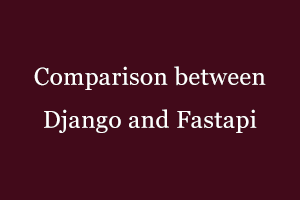Django
Django is a Python web development framework that is free and open-source. It is used to create websites. Adrian Holovaty and Simon Willison invented it in 2003, and it followed the Model-Template-View architecture.
It is well-known for its toughness and simplicity. It’s one of the most widely used frameworks in the world, with companies like Instagram, Youtube, and others using it. Django is also well-liked because it promotes the reuse of code.
Pros
- Django’s coding structure is extremely efficient, making it simple for developers to add new features to their websites.
- In Django, you can use the Rest framework (Representational state transfer is a software architectural style that sets a set of restrictions to employ when designing web services). Django Rest Framework is the name of this framework (DRF). It’s a Django-based toolkit for creating Web APIs.
- REST is a universal framework, whereas DRF is a Django-specific REST framework. Django’s flexible and extensible architecture makes it simple to create Web APIs.
- Django prioritizes security by defending against cross-site request forgery and joint SQL injection attacks.
Cons
- Because of the many reused modules, Django’s bulky software may slow down development. It also has to ensure that prior versions are compatible with future ones, which adds to the slowness of the process.
- Models in Django can’t have mixins; they can only have a straightforward inheritance.
- Django employs ORM, which was developed before SQLAlchemy. As a result, Django ORM is less flexible than SQLAlchemy.
FastAPI
FastAPI is a modern, open-source, fast, and highly performant Python web framework that is built on Python 3.6+ standard type hints and is used to create Web APIs.
Pros
- Even in deeply nested JSON requests, fast API checks the developer’s data type.
- Fast API is based on industry standards such as JSON Schema (a tool for evaluating the format of JSON data), OAuth 2.0 (an industry-standard authorization mechanism), and OpenAPI (which is a publicly available application programming interface)
- With the graphene-python Python package, FastAPI makes it simple to create a GraphQL API.
Cons
- FastAPI has a limited community compared to other frameworks because it is so young, and despite its extensive documentation, there are very few external teaching resources.
FastAPI Use cases
If you’re concerned about speed, this API is ideal. Netflix uses it to deal with internal crises. It also scales beautifully when it comes to deploying production-ready machine learning models, as ML models operate best in production when wrapped in a REST API and provided as a microservice.
Comparison
Now we’ll compare Django and FastAPI in terms of packages, community, performance, flexibility, job availability, and education.
Packages Django has the most packages that facilitate the reusability of code among Django and FastAPI. Unlike FastAPI, which is a simple framework for constructing quick websites, it is a full-stack web development framework.
Community Next to Flask, which has a thriving community, Django has the most significant community due to its widespread use and popularity. FastAPI, on the other hand, has a small user base due to its newness.
Performance FastAPI leads in terms of performance because it is focused on speed, followed by Flask, and finally slow Django.
Developers place a high emphasis on flexibility, and Flask is more flexible than Django. Fast API, on the other hand, is code-flexible and does not impose any restrictions on the layout of the code. As a result, we may argue that Flask is the most adaptable of the three.
Education Django is more difficult to learn, yet it comes with a wealth of online materials and resources. Flask is simple and uncomplicated, with a wealth of online materials and resources, whereas Fast API is the most straightforward if you’re new to web development but with the fewest online resources.
Conclusion
After carefully examining them, you may be able to determine which one is ideal for you. In conclusion, Django is ideal for building powerful full-stack websites since it offers a wide range of features and performs well in production.
Flask is ideal for machine learning engineers or developers who want to quickly prototype a web application and build APIs easily and quickly. At the same time, If you need speed or scalability, FastAPI is the way to go. It’s usually best to pick a framework based on your needs, but they’re all solid in general and have a lot of market demand.
People having good knowledge of Financial accounting can get an Accounting Certification Exams from StudySection to increase their chances of getting a job in this field. You can get a foundation level certification if you are new to Financial accounting or you can go for advanced level certification if you have expert level skills in Financial accounting.




